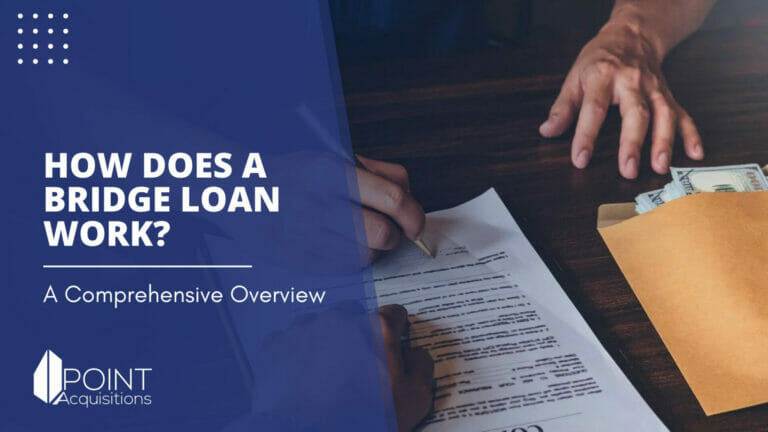
Bridge Loans: What You Need to Know
A bridge loan can be a lifesaver for business owners looking to expand but don’t have the time to wait for traditional loans.
The concept of bridging loans has existed for over 200 years, helping homeowners and businesses navigate their short-term financial needs. These short-term loans can help you cover the gap between your current situation and your long-term goal. The popularity of bridge loans has grown, particularly in active real estate markets where the competition is high and the ability to move quickly can make all the difference in securing a property.
This blog post will discuss what a bridge loan is, how they work, and some of the pros and cons of using them. We will also provide you with a few tips on applying for a bridge loan.

Table of Contents
What is a bridge loan?
A bridge loan is short-term financing until a customer or company gets long-term funding or pays off existing debt. It allows the user to fulfill current obligations by providing quick cash flow. Bridge loans typically is a one-year or less term with a high-interest rate, generally secured by real estate or inventory assets. A one-time loan used to acquire a secured property is a bridge or bridging loan.
Bridge loans are similar to home loans because they can be authorized swiftly if a pressing need exists. Because there is the potential of losing your property, a bridge loan is sometimes called a loan of last resort.
How Does It Work?
Bridging loans fill the gap when money is required but not yet accessible. They span the gap when it comes to financing. Businesses and individuals utilize bridge loans, which can be tailored to meet various demands.
The amount is limited by the amount of money you have on hand. The maximum loan, including interest, is limited to a percentage of the property’s value, secured by a mortgage or multiple mortgages. A bridge loan, unlike a mortgage, is not directly related to your earnings.
A home equity loan allows homeowners to acquire a new house while waiting for their existing one to sell. Borrowers use the equity in their current house to put down on a new property. When homeowners look to sell their old house, they’re often in a bind. The faster you get the job done, the sooner your customers will be back in action.
Before applying for a bridging loan, assess the advantages and disadvantages. Personal loans are typically more expensive than home equity lines of credit (HELOCs) due to their higher interest rate. Those who haven’t paid their mortgage must now make two payments—one for the bridge loan and one for the mortgage payments.
Benefits of a Bridge Loan
- It is feasible to borrow enormous sums of money. You may borrow the funds to keep your property purchase on track in minutes.
- Payments may be made monthly, quarterly, or annually.
- Lending on real estate may be obtained where high street lenders would not.
Disadvantages of Bridging Loans
- Bridging loans typically are secured loans, so you’ll need to post something as collateral. You risk losing that asset, for instance, the subject property, if you can’t repay the bridging loan.
- You pay a higher interest rate for the convenience of fast, flexible finance.
- Lenders charge various costs when you take out a bridging loan, which adds to the overall cost.
Using a Loan
According to the U.S. Small Business Administration (SBA), bridge loans are especially valuable for businesses experiencing rapid growth that needs to move into larger spaces without waiting for existing properties or assets to sell. Almost any legal purpose may be accomplished with bridging loans, including:
- You can buy a property before the current one is sold on stay in a chain.
- Purchasing real estate at an auction.
- Purchasing property in terrible condition.
- Paying past due obligations and covering unanticipated expenditures.
- The procedure for bankruptcy clearance
- Restoration, repair, and remodeling projects are all supported by our funding.
- You are finding the cash you need to keep your company operating.
- While other funds are being allocated, the gap is being closed.

Interest Rates on Bridging Loans
The average bridge loan interest rate typically is higher since you’re paying for the opportunity to borrow a large amount of money quickly. Borrowers who take out bridging loans are charged interest every day rather than once a year. Depending on the loan, you may anticipate paying anything from 6% to 20%APR (Annual Percentage Rate). Bridging loans for house purchases are far greater than the mortgage interest you pay on the best mortgage alternatives available today.
Unlike a traditional mortgage, interest on a bridging loan is charged in three different ways:
Monthly – An amortization schedule is another option, similar to an interest-only mortgage, in which you pay the interest only payments each month but do not increase the principal balance.
Rolled up – Interest payments are added to the loan and paid out when the bridging loan is completed.
Retained – You borrow the interest upfront for a set time and return any unused interest to you when the loan is paid back.
Cost of Bridging Loans
Bridging loan lenders borrow from the federal funds rate to establish their interest rates. These are usually lower than bank loan interest rates, ranging from 3% to 8.5% or 10.5%. The business bridge loan rates are much higher, typically ranging from 15% to 24%. Closing costs and fees on a bridge loan are typically 1.5% and 3% of the total amount borrowed.
There are some additional costs associated with taking out such a loan. These include:
- The lender charges a fee for arranging the loan – usually about 2% of the loan and added to the principal.
- The administration fee is sometimes paid upfront.
- Part of the total cost is paid upfront to your conveyancing solicitor and the rest on completion.
- Costs for valuations vary depending on the lender and how quickly you need the cash.
- Broker’s fees are commonly paid on receipt of the mortgage offer and range from a flat fee to a percentage of the loan.

What Are the Different Types of Bridge Loans?
The types of bridging loans available to borrowers may change based on their creditworthiness and financial requirements. As a result, while bridge loans are usually classified, their interest rates, repayment methods, and loan terms vary.
What if I want to borrow money to buy a house? As previously said, loan requirements differ from lender to lender, and generally must now own property. You may use 80% of your present residence’s loan-to-value (LTV) to borrow.
Only bridge loan lenders that provide a new mortgage with the same company give bridge loans to consumers who obtain both mortgages. You’ll need to provide evidence of income to demonstrate that you can afford the mortgage on your new house. The cost of the bridge loan may or may not be included in your debt-to-income ratio, depending on the lender. For more information on different types of real estate loans check out our blog.
Closed bridge loans
A closed bridging loan is temporary financing in which the lender and borrower agree on a specific time frame (usually a few months). Because the lender has greater confidence in repayment, closed, bridging loans are typically more accessible.
Open bridge loans
No set repayment date is required for open bridge loans. Because of the greater uncertainty surrounding the repayment, interest rates for open bridging loans are generally higher. As a result, they might be an appealing choice for people who do not know when they will be able to access the cash to pay off the loan.
First charge bridging loans
A first charge bridging loan is one in which the property/asset being used as collateral has no additional liens; for example, it may entirely pay off the mortgage. The bridging loan provider can sell the property if there is a default on loan.
Second charge bridging loans
A second charge bridging loan is generally given to individuals who need finance but have a mortgage on the property being used as collateral. In other words, the asset has already had a “first charge.”
Debt bridge financing
Debt bridge financing is a type of short-term credit that allows a firm to start operations while it waits for long-term capital. In terms of its function, the loan is comparable to a bridge because it connects the borrowed firm to debt funding. Knowing what interest you’ll be charged if you opt for a debt bridge loan is critical since you don’t want to exacerbate any previous financial issues.
Equity bridge financing
Equally, some firms want to avoid paying high-interest rates, which is why they look for equity bridge financing. This is when a venture capital firm offers the firm money in the form of a bridge financing round to tide them over until it can raise equity cash, for example.
The borrowing company may offer equity ownership in the lending business to obtain the funds in exchange. The CRE Investment will base its decision to lend on whether or not they believe the firm will be profitable, increasing its value.
Fast non status bridging loans
With Fast Non-Status Bridge Loans, property investors and developers can obtain funding without worrying about their finances or credit history. Instead, the criteria for lending are focused on what you’re trying to protect: your assets.
IPO bridge financing
Bridge financing is a type of lending that allows businesses to obtain finance before their initial public offering (IPO). The money raised from the IPO is used to pay off the loan, usually given by the investment bank that is underwriting the new issue. The borrowing firm offers the underwriters shares at a discount on the offering price, thereby offsetting the loan. The IPO procedure might be costly, so bridging finance alleviates short-term financial burdens.

Alternative Lenders for Bridge Loans
Although bridge loans are costly and challenging to qualify for, they aren’t suitable for everyone. Consider these additional financial solutions if bridge loans aren’t appropriate for you:
Home Equity Loans: A home equity loan allows you to borrow against the value of your current house. Unlike a bridge loan, you’ll generally be required to make immediate monthly payments with a home equity loan.
A home equity loan is usually long-term and has higher interest rates than a bridge loan. Even though you’ll only have one mortgage, you may still need to carry two.
Home Equity Line of Credit (HELOC): A HELOC, as the name suggests, allows you to access a credit line rather than a loan. The credit line is based on your home’s equity. A line of credit, like a home equity loan, may not be big enough to cover the expenses associated with moving into your new property.
You may be eligible for a lower interest rate than you would with a bridge loan. You can also finance home improvements with a HELOC. However, if you had to get a HELOC before putting your property on the market, some lenders will not offer one to a home for sale.
A Cash-Out Refinance Loan: Taking out a new mortgage larger than your existing one and converting your property’s equity to cash is known as refinancing. The main disadvantage is that your mortgage payments on the refinance loan will be included in your debt-to-income ratio when you apply for a mortgage to purchase the new house.
80-10-10 Loan: A zero-down, 80/10/10 loan allows you to buy a new house with less than a 20% down payment while avoiding private mortgage insurance (PMI) fees. Under an 80-10-10 loan, you put a down payment of 10% and borrow two mortgages: one for 80% of the asking price and a second for the remaining 10%. After selling your old house, you may pay off the 10% second mortgage on the new property with any remaining cash.
Business Line of Credit: This is a revolving loan that businesses may apply to cover short-term expenses. Because no lump sum is given, the borrower is only charged interest on what they spend. Standard banks offer these loans at fixed rates (usually 7% or higher), while variable-rate loans range from a few months to ten years and have interest rates that vary by lender.
On the other hand, Internet lenders charge considerably greater interest rates than conventional banks, ranging from 4.8 percent to 99 percent. Smaller firms may use a business line of credit to cover unanticipated costs or replenish inventory. It’s built for fast use to meet short-term demands, such as picking up some items.
Personal Loan: Finally, in such cases, personal bridging loans can be a great alternative because they are quick to approve and pay off; you might go after personal financing. Depending on the lender’s various terms and conditions, personal possessions are used to secure this loan.
Businesses and Bridge Loans
When a company needs immediate cash to cover operating costs in the meantime, it turns to bridge loans. Consider a firm with six months until it completes a round of equity financing. A business may use a bridge loan to tide it over until the fundraising round is completed, providing working cash for operating costs like payroll, rent, utilities, inventory expenditures, and other expenses.
Cash advances can be used for various purposes, including financing property acquisitions quickly and taking advantage of stock discounts.

Bridge Loans in Real Estate
In the realm of real estate, interest-only loans also exist. A bridge loan is provided when a buyer has a gap between purchasing and selling one property. Bridge loans for real estate are typically given to people with strong credit and debt-to-income ratios deemed acceptable.
Rollover mortgages combine the loans on two properties, allowing purchasers to wait for their old house to sell while still having options. However, in most situations, lenders provide real estate bridge loans representing just 80% of the value of the two properties combined, requiring the borrower to have significant equity in their initial property or a lot of cash savings.
Bridge Loans vs. Traditional Loans
Lenders specializing in bridge loans have quicker applications, approval, and funding than national lenders. However, these loans have short durations, hefty bridge loans interest rates, and significant origination fees to offset this simplicity. Borrowers usually agree to these conditions since they provide fast and easy access to money. They are prepared to pay high-interest rates because they understand the loan is short-term and will be paid off with low-interest, long-term financing. Most bridge loans do not include any penalties for early repayment. Check out our blog on the different types of real estate loans for more information.
Conclusion
Bridge Loans are a type of short-term loan typically used to finance the purchase of a new property before the borrower’s current property is sold. Bridge Loans have both advantages and disadvantages. Some advantages include buying a new property before selling your current one, and having more negotiating power when buying a new one.
Some disadvantages include paying two mortgages at once, potentially high-interest rates, and the need to sell your current property quickly to avoid defaulting on the loan. Bridge Loans can be a helpful tool for those looking to purchase a new property before their current one is sold, but it is important to weigh the costs and risks before taking out a Bridge Loan.
About The Author

Jesse Shemesh
Disclaimer
Please note that Point Acquisitions is not a tax expert or tax advisor. The information on our blogs and pages is for general informational purposes only and should not be relied upon as legal, tax, or accounting advice. Any information provided does not constitute professional advice or create an attorney-client or any other professional relationship. We recommend that you consult with your tax advisor or seek professional advice before making any decisions based on the information provided on our blogs and pages. Point Acquisitions is not responsible for any actions taken based on the information provided on our blogs and pages.
1031 Exchange Capital Gains Tax Deferral
According to a 2021 report by the National Real Estate Exchange Services (RES), over 240,000 1031 exchange transactions were completed in the United States, totaling $100 billion. This impressive figure underscores the role of 1031 exchanges in the real estate…
Read More1031 Exchange Benefits
As of Q4 2023, the national vacancy rate for all commercial property types in the United States sat at 9.2%, according to CBRE’s latest insights and research. This represents a slight decrease compared to the previous quarter and suggests a…
Read MoreUnderstanding Commercial Property Value
The art of commercial real estate valuation is a critical skill in an industry teeming with over $1 trillion in yearly transactions. Our detailed guide on how to value commercial property is designed to elevate your expertise and give you…
Read More

